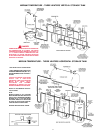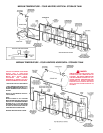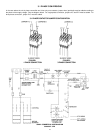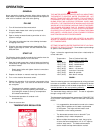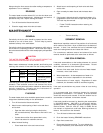
18
OPERATION
GENERAL
Never operate the heating elements without being certain the
water heater is filled with water, and a temperature and pressure
relief valve is installed in the relief valve opening.
FILLING
1. Turn off the electrical disconnect switch.
2. Close the water heater drain valve by turning knob
to right (clockwise).
3. Open a nearby hot water faucet to permit the air in the
system to escape.
4. Fully open the cold water inlet valve allowing the heater
and piping to be filled.
5. Close the hot water faucet as water starts to flow. The
heater is now ready for START UP and TEMPERATURE
REGULATION.
START UP
The following checks should be made by the installer when the
heater is placed into operation for the first time.
1. Open the hinged access door, check all water and electrical
connections for tightness. Also check connections on top
and side of heater.
• Repair water leaks and tighten electrical connections
as necessary.
2. Depress red button on manual reset high limit switch.
3. Turn on the electrical disconnect switch.
4. Observe the operation of the electrical components during
the first heating cycle. Use care as the electrical circuits
are energized.
• Thermostat and contactor operation should be
checkedby (a) manually operating thermostat and
(b) allowing the heater to come up to temperature
and shutoff automatically.
• The thermostat operates all contactor coils
simultaneously.
5. Close the access door.
TEMPERATURE REGULATION
DANGER
THIS WATER HEATER IS EQUIPPED WITH AN ADJUSTABLE
THERMOSTAT TO CONTROL WATER TEMPERATURE. HOT
WATER TEMPERATURES REQUIRED FOR AUTOMATIC
DISHWASHER AND LAUNDRY USE CAN CAUSE SCALD
BURNS RESULTING IN SERIOUS PERSONAL INJURY AND/
OR DEATH. THE TEMPERATURE AT WHICH INJURY OCCURS
VARIES WITH THE PERSON’S AGE AND TIME OF EXPOSURE.
THE SLOWER RESPONSE TIME OF DISABLED PERSONS
INCREASES THE HAZARDS TO THEM. NEVER ALLOW SMALL
CHILDREN TO A HOT WATER TAP, OR TO DRAW THEIR OWN
BATH WATER. NEVER LEAVE A CHILD DISABLED PERSON
UNATTENDED IN A BATHTUB OR SHOWER.
THE WATER HEATER SHOULD BE LOCATED IN AN AREA
WHERE THE GENERAL PUBLIC DOES NOT HAVE ACCESS TO
SET TEMPERATURES.
SETTING THE WATER HEATER TEMPERATURE AT 120°F WILL
REDUCE THE RISK OF SCALDS. Some states require settings
at specific lower temperatures.
Figure 1 shows the approximate time-to-burn relationship for
normal adult skin.
Temperature Time to Produce 2nd & 3rd
Setting Degree Burns on Adult Skin
180°F (82°C) Nearly instantaneous
170°F (77°C) Nearly instantaneous
160°F (71°C) About 1/2 second
150°F (65°C) About 1-1/2 seconds
140°F (60°C) Less than 5 seconds
130°F (54°C) About 30 seconds
120°F (49°C) More than 5 minutes
FIGURE 1
Valves for reducing point-of-use temperature by mixing cold and
hot water are available. Also available are inexpensive devices
that attach to faucets to limit hot water temperatures
Contact a
licensed plumber or the local plumbing authority.
The thermostat factory setting is 130°F. The dial is adjustable
through a range of 95° to 194°.
The thermostat is behind the front access door. TURN OFF THE
ELECTRICAL DISCONNECT SWITCH BEFORE OPENING
DOOR.
• It is suggested the thermostat be turned to the lowest
setting which satisfies the hot water requirements
of the system. This helps minimize water scale
formations on the heating elements.
• The thermostat contacts close on about 6°F (not
adjustable) drop in water temperature.
• Where multiple thermostats are used, they may be
all set at the same temperature or 2° to 4°F apart to
achieve “step control”. The bottom thermostat is
set the hottest and top thermostat the coolest.





